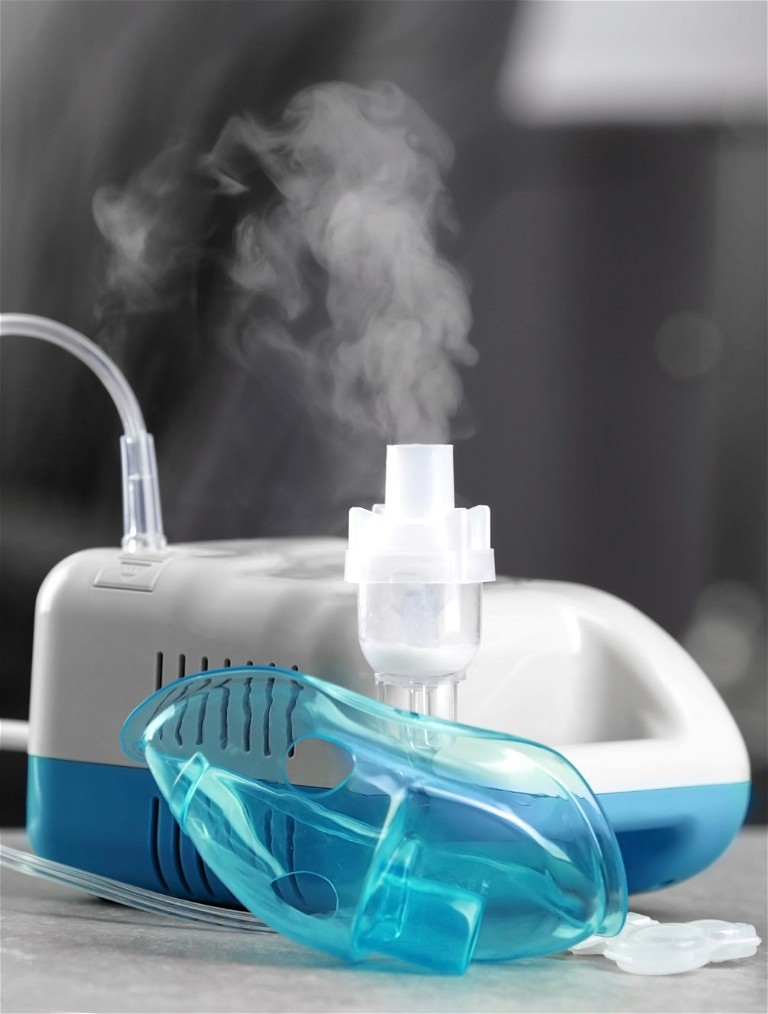Manufacturing: pMDIs, SMIs, DPIs and nebulisers
Inhaled medicines and particle size analysis
Drug administration by inhalation is an established technique for treating respiratory and systemic diseases. Effective drug delivery to the lungs requires the aerosolisation and dispersion of a formulation into particles or droplets in the inhalable size range, typically an aerodynamic diameter below 5 µm.1 In many cases, particle engineering is used to optimise a formulation for efficacy
Paul Hardman at Broughton
Orally inhaled products (OIPs) can be used to treat respiratory diseases and systemic uptake to treat illnesses elsewhere in the body, such as pain management and diabetes treatment. The management of respiratory disease is the most common application for OIPs, forming the cornerstone of treatment regimens for asthma and chronic obstructive pulmonary disease (COPD) for millions globally.
There are four main device types used for inhalation therapy: pressurised metered-dose inhalers (pMDIs), soft mist inhalers (SMIs), dry powder inhalers (DPIs) and nebulisers. Within these categories are a range of inhalers designed with various specific features. However, the most commonly used type of device is the pMDI, primarily due to its portability, ease of use and cost-effectiveness.
Why is inhalation therapy an area of growing interest?
Generally, inhalation therapy brings several benefits over other delivery mechanisms, such as intravenous injection, tablets and capsules.
Firstly, there is the advantage of targeting various regions of the airways. In addition, inhalation therapy enables the potential for delivery of medicines into the lung’s alveolar spaces for systemic uptake, resulting in rapid absorption to oxygenated blood − the active substance achieves systemic circulation and arrives at the target organ relatively intact and quickly.
Intravenous injections, on the other hand, rely on the delivery of the substance into deoxygenated blood, which first requires passage around the body, through the heart and lungs, before reaching the target organ. This relative delay can result in significant metabolism of the active substance before it reaches the target organ. Therefore, inhalation therapy can achieve efficacy with a lower dose, potentially reducing the risk of side effects and adverse events.

Because of these benefits, there is potential for inhalation therapy to treat conditions where there is currently an unmet clinical need. Researchers are investigating how inhalation therapy can be expanded into new areas and be improved in existing applications.
Tailoring inhalation therapy
To achieve efficacy with inhalation therapy, the active substance’s deposition in the correct location is critical, and the correct administration depends on several factors related to the drug’s formulation, device design and patient use.
For systemic absorption, aerosol droplets or particles must be of a size that minimises deposition on the back of the throat or in the bifurcations of the bronchi to ensure that as much active substance as possible is delivered to the alveoli. In contrast, to treat a disease related to the throat, trachea or upper airways, the particle size should be larger to ensure deposition in those locations, limiting the dose delivered to the lung as any systemic absorption may lead to undesirable side effects.
Many device and formulation combinations are available for physicians to prescribe, depending on the presentation and where the drug must be deposited. The choice of product is not always straightforward. Disease presentation can vary from patient to patient – two patients taking the same drug product and using the same device may not achieve the same drug deposition. For example, researchers and clinicians have come to understand the diversity in how asthma presents in different patients: the underlying inflammation in the lung, as well as how the clinical features of the disease, differ between patients.2 Understanding the phenotype can help clinicians and other healthcare professionals to prescribe more effective treatment regimens where drugs are targeted at the relevant part of the respiratory system.
Patient adherence is another important factor in the treatment regime’s success, as their inhalation technique influences drug distribution. To help address this, medical professionals can work with patients to help train them on appropriate device use. Innovations in device design may also help address the issue of patient inhalation variability.
Particle engineering
As well as patient factors, such as individual patient anatomy, age and sex, lung deposition depends on the properties of the drug particles, including their size, shape, density, hygroscopicity, velocity and charge.3 To improve drug efficacy, inhaler producers can develop formulations and devices with engineered particles to facilitate better distribution and deposition along the respiratory tract.4
Particle size engineering has been used for many years to change the properties of a drug formulation to enable it to be delivered more effectively. It is performed for several reasons, such as to improve bioavailability and solubility or to optimise for a particular delivery format such as a DPI. Significant effort has already been invested in improving the aerosol performance of many inhaled formulations.
Two common particle engineering methods are micronisation, used to create drug substance particles within the desired size range, and amorphous solid dispersion (ASD), to improve a formulation’s solubility, bioavailability and stability. Spray drying is commonly used to prepare ASDs in powdered form, combining heat and atomisation. Micronisation is commonly achieved using milling technology, such as mechanical or jet milling. The choice of the particle engineering approach, of which only two have been highlighted here, depends on several factors, such as the physicochemical properties of the drug substance and excipients and the requirements set out in the product’s target product profile (TPP).
It is important to note that carrier-based blends are a common formulation choice for DPI formulations, where micronised drug particles are formulated with larger carrier particles, typically lactose.5 The drug adheres to the carrier surface, enabling the formulation to act as a free-flowing powder. Carrier particles can also be engineered to alter their properties to improve efficacy by altering particle size, shape and morphology using techniques like milling and sieving or by reducing the drug substance adhesion to the carrier through a force control agent to alter the carrier’s surface.6
Dry powder inhalers are generally considered the most stable but most challenging delivery device due to the characteristics of micronised materials. For example, their high surface energy can make them cohesive and prone to low flowability, requiring additional engineering to ensure stability and optimal dispersion, or there may be effects on performance due to static charges that can lead to formulation ‘relaxation’ periods post-mixing.5
Novel engineering techniques
Alongside well-established techniques, novel techniques are emerging that pharmaceutical manufacturers may wish to trial to improve the performance of their formulation. Nanoparticles, for example, can enable site-specific delivery and cellular uptake and have been shown to modulate immune responses.7 Other methods include spray freezing, homogenisation, liposome structures and the formation of co-crystals. However, many novel technologies and techniques are yet to be practically applied, which may be because the right active pharmaceutical ingredients (API) and opportunities have yet to arise. Novel techniques have their specific benefits along with formulation and scale-up challenges.
Particle size analysis
Particle size analysis is essential to understand the likelihood of drug particle deposition in the desired part of the respiratory tract. Particle size is normally measured as aerodynamic diameter, as there is a direct relationship between this and the transportation mechanics from the device to the deposition location.8
The choice of analytical technique will depend on the device’s requirements and the desired particle properties. Several particle size analysis techniques are available, including cascade impaction, laser diffraction, sieve analysis, dynamic light scattering and direct imaging. Laser diffraction, for example, measures the angular variation of light scattered as a laser beam passes through the sample and may be useful for assessing aerosols consisting of droplets with a known refractive index. Sieve analysis may be useful as a quality control test to ensure the correct size fractions of carrier particles are used in the formulation.
“ Particles impacted at each stage can then be assessed for their mass, chemical composition or morphology ”
Cascade impactors are typically used to determine the mass-weighted aerodynamic particle size.9 Cascade impaction provides the aerodynamic diameter of drug particles by using aerodynamic forces to separate the aerosol via a set of nozzles that gradually reduce in diameter. The nozzles create a jet of aerosol directed at a collection plate. Particles larger than the effective cut-off diameter the nozzles provide are impacted on the plate for analysis and smaller particles are carried in the airstream to the next stage, where there are smaller diameter nozzles. The smaller nozzles create a faster jet, creating a smaller effective cut-off diameter, leading to even smaller particles impacting the collection plate. The impactor has a set of several nozzles to repeat the process to effectively separate the aerosol into a series of collections of various aerodynamic particle sizes.
Particles impacted at each stage can then be assessed for their mass, chemical composition or morphology. The flow rate can be altered according to the device being tested − a nebuliser will be tested at a lower flow rate (15 litres per minute) compared with a pMDI that may be tested at 28.3 or 30 litres per minute depending on the type of impactor used.
Although aerosol characterisation can only be briefly touched on in this article, it is complex. It can help to work with an expert who can talk you through the process to ensure the most appropriate studies are conducted at the various stages of product development. An inhaled medicine specialist can help the manufacturer understand the particle size distribution profile and consult on amendments to the formulation or device that could improve efficacy. A good consultant will understand the relationship between formulation and device, as these things must be developed in parallel.
Inhaled medicines are a vital part of disease management, and assessing particle size and particle engineering techniques are key areas of interest when improving current drug delivery devices and developing new ones.
References
- S P Newman (2017), 'Drug delivery to the lungs: Challenges and opportunities,' Theraputive delivery
- Visit: aaaai.org/tools-for-the-public/conditions-library/asthma/asthma-is-a-disease-of-different-phenotypes
- I Gonda (2006), 'Systemic delivery of drugs to humans via inhalation,' Journal of Aerosol Medicine
- N Schichilone (2015), 'Asthma Control: The Right Inhaler for the Right Patient,' Advances in Therapy
- A H de Boer et al (2017), 'Dry powder inhalation: past, present and future,' Expert opinion on drug delivery
- G Hebbink et al (2022), 'Recent developments in lactose blend formulations for carrier-based dry powder inhalation,' Advanced Drug Delivery Review
- F Blank et al (2017), 'Interaction of biomedical nanoparticles with the pulmonary immune system,' Journal of Nanobiotechnology
- J P Mitchell (2021), 'Particle Size Measurements from Orally Inhaled and Nasal Drug Products,' J Aerosol Med Pulm. Drug Delivery
- D L Roberts et al (2019), 'Measurement of Aerodynamic Particle Size Distribution of Orally Inhaled Products by Cascade Impactor: How to Let the Product Specification Drive the Quality Requirements of the Cascade Impactor,' AAPS Pharm Sci Tech

Paul Hardman, as managing consultant, chemistry at Broughton, manages a team of consultants specialising in understanding product chemistry across pharmaceutical and consumer products. Paul studied a BSc in Pharmacology at the University of Sheffield, UK, and commenced his career at Vectura, where he gained extensive experience developing dry powder inhaled medicines. He was the co-inventor of a novel powder dispersion engine design for a passive dry powder inhaler, with potential for use across a range of APIs and with a range of inhalers.